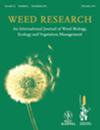生境管理对濒危苔科植物新种的影响
IF 2.2
3区 农林科学
Q2 AGRONOMY
引用次数: 0
摘要
大蒜矢车菊(Mummenhoffia alliacea)是一种罕见的芸苔科杂草,在匈牙利受到保护。在2021年,发现了三个新的物种地点。除了这些以前不为人知的事件外,还对一项已知时间较长但尚未发表的路边事件进行了详细研究。本研究的主要目的是了解刈割和冬季除冰等生境管理措施对种子质量和萌发的影响。较早采集的种子质量明显低于较晚采集的种子质量,表明晚春刈割对葱属植物的繁殖最有利。刈割方式(将茎切成小块或在离地几厘米的地方将茎切成小块)对种子发芽没有显著影响,但对种子质量有显著影响。完整个体的种子质量显著高于切碎个体的种子质量,表明传统割草方式比现代割草方式更有利于该物种的生存。观察到萌发的最高NaCl(用于冬季除冰)浓度为0.75 m/m%(质量百分比),与自然界的强盐渍土相当。新发现的地点都受到了干扰,其中一个位于路边(铺路和土路),两个位于堤岸,这表明人类栖息地可能是该物种的最佳栖息地,但长期生存取决于这些栖息地的管理。本文章由计算机程序翻译,如有差异,请以英文原文为准。
Effects of habitat management on newly found populations of the endangered weed, Mummenhoffia alliacea (Brassicaceae)
Garlic pennycress ( Mummenhoffia alliacea ) is a rare weed of the Brassicaceae family, protected in Hungary. In 2021, three new sites of the species were discovered. In addition to these previously unknown occurrences, a detailed study of a roadside occurrence known for a longer time but not yet published was carried out. Main aim of our study was to find out how habitat management practices, such as mowing and winter-deicing effects seed mass and germination. Seeds collected earlier had significantly lower mass than those from later collections, suggesting that late-spring mowing would be optimal for the reproduction of M. alliacea . The type of mowing (chopping the stem into small pieces or cutting the stem at one point at few centi-metres above ground) had no significant effect on seed germination but did have a significant effect on the seed mass. Seed mass deriving from whole individuals was significantly higher than seed mass of chopped individuals, suggesting, that traditional mowing methods are better than the use of modern lawnmowers for the survival of the species. The highest NaCl (used for winter-deicing) concentration where germination was observed was 0.75 m/m% (mass percentage), which is comparable with strongly saline soils in nature. The newly discovered sites were all disturbed, one of which was located on roadsides (paved and dirt roads) and two on embankments, suggesting that anthropogenic habitats could be optimal for the species, but the long-term survival depends on the management of these habitats.
求助全文
通过发布文献求助,成功后即可免费获取论文全文。
去求助
来源期刊

Weed Research
农林科学-农艺学
CiteScore
4.30
自引率
0.00%
发文量
41
审稿时长
12-24 weeks
期刊介绍:
Weed Research is an international peer-reviewed journal that publishes topical and innovative papers on weed science, in the English language. Its aim is to publish the best weed science from around the globe and to be the journal of choice for weed science researchers. It is the official journal of the European Weed Research Society. Papers are taken on all aspects of weeds, defined as plants that impact adversely on economic, aesthetic or environmental aspects of any system. Topics include, amongst others, weed biology and control, herbicides, invasive plant species in all environments, population and spatial biology, modelling, genetics, biodiversity and parasitic plants. The journal welcomes submissions on work carried out in any part of the world.
 求助内容:
求助内容: 应助结果提醒方式:
应助结果提醒方式:


